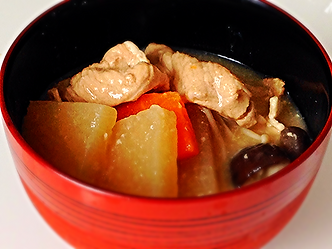AUTHENTIC JAPANESE COOKING CLASS AT HOME
IN KAMAKURA
Class in English with Mariko
”Washoku” traditional Japanese cuisine has been added to UNESCO insensible cultural heritage list on 2013.
You can visit a local home to experience and enjoy a real Japanese meal with
professional Japanese a cook Mariko.
梅
History of the origin of Samurai and their dietary habits
As they were originally peasants who cared for the farmland owned by their families, samurai had a close connection with agriculture.
They also cooked for themselves rather than leave it to the womenfolk, and their dietary habits (two meals a day except during wartime),
menu ( and ichiju-issai - one bowl of soup, one vegetable dish), and cooking methods (based on “grill”, “boil”, and “steam”), were all simple and logical.
The meals of the Kamakura samurai
The basis of modern Japanese cuisine – rice, soup, vegetables. This simple and logical style was created by the Kamakura samurai, who defeated the aristocratic Heike clan at the battle of Dannoura and established a new era in the Kanto region.
The meals of a samurai, not limited to only the Kamakura samurai but from the warriors of ancient times right up to the early Edo period, was basically two meals a day, with five measures of rice. Two and a half measures in the morning and the remaining two and half measures to gain strength as an evening meal.
Regarding ichiju-issai, the rice at the time was usually unpolished so it had a better nutritional balance than the modern version. has more vitamins, minerals and fiber than white rice, and if we calculate the calories in five measures, it is about 2400 calories from the rice alone.
This is the same as the daily calorie intake of an adult Japanese male today. Ichiju-issai also includes soup and, for example, grilled fish, so the total calories intake is over 3000.
For martial arts training, they would go to the mountains, and hunt wild boar or deer, so they were far healthier than the Heike clan, who had become aristocrats in their seat of power.
Example: brown rice, grilled fish, grilled chicken, mustard spinach, burdock root boiled in kelp stock, daikon radish soup, and pickled plum. (Samurai began the custom of eating rice topped with a pickled plum. Today just about any bento lunch has a pickled plum on top of white rice.)
The eating habits of the Genji, victors at the battle of Dannoura
It is said that the different daily eating habits of the Heike and Genji clans had an effect on the outcome of the battle of Dannoura in 1185. Compared to the nutritionally balanced diet of the samurai fighting for the Genji clan, those fighting for the Heike clan had a more aristocratic diet, and this led to a major difference in strength between the two sides.
At the center of the Heike clan’s diet was white rice and preserved foods. In contrast, that of the Kamakura samurai was simple and logical, based around brown rice and fresh vegetables, meat and fish, and in this form their diet epitomized their life philosophy of speed and simplicity.
At the end of the Kamakura era, Kusunoki Masashige is said to have stood over 180cm tall. At the very least, it is said that men were not small at that time.
Regardless of the Buddhist taboo against eating meat, the Genji (samurai of the eastern provinces) gained their strength from eating a lot of animal protein. So there is a theory that in the battle between the two clans, the Heike clans were defeated because of their aristocratic diet that didn’t include meat and their deteriorating food situation due to a poor harvest in western Japan.

